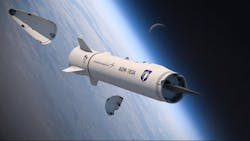GE Global Research to develop ways to enable sensors to withstand the shock and heat of hypersonic flight
ARLINGTON, Va. – U.S. military researchers are asking General Electric Co. to develop rugged RF radomes and infrared windows able to withstand the severe heat, shock, and vibration of hypersonic flight.
Officials of the U.S. Defense Advanced Research Projects Agency (DARPA) in Arlington, Va., announced a $7.5 million contract Thursday to the General Electric GE Global Research Division in Niskayuna, N.Y., for the High Enthalpy Aperture Technology (HEAT) project.
HEAT seeks to demonstrate new material approaches and solutions to enable RF and infrared apertures on hypersonic missiles and aircraft to withstand extremes in heat and dynamic pressure. Hypersonic vehicles typically fly faster than five times the speed of sound.
GE Global Research joins the Lockheed Martin Corp. Missiles and Fire Control segment in Orlando, Fla., and the Georgia Tech Research Corp. in Atlanta on the HEAT project. Lockheed Martin won a $2.5 million HEAT contract on 11 Feb., and Georgia Tech won an $8.3 million HEAT contract on 3 Feb.
The HEAT program is a classified effort, so GE Global Research, Lockheed Martin, and Georgia Tech must use their facility clearance licenses and use personnel with collateral secret security clearances.
High-speed aerospace systems like hypersonics require RF radomes or infrared windows to protect sensitive electronics from the environmental extremes of high-speed flight while providing transparency for radar and RF communications transceivers and infrared sensors used for guidance, communications, and sensing.
These aperture materials must withstand extreme thermal, mechanical, and chemical environments during hypersonic flight that can limit their performance. For example, shock waves and high heat loads can impose wavefront distortions and boresight errors on guidance electronics.
Solutions may involve affordable and manufacturable means of controlling thermo-optical and elastic-optical effects; maintaining desired transmission amplitude and bandwidth; and reducing thermal deformation, mismatch, and radiation.
Related: The electronics design challenges of hypersonic flight
The HEAT program is a four-year, two-phase effort, which is divided into three technical areas: integrated RF aperture materials; infrared aperture materials; and next-generation aperture materials.
The three companies will consider new materials approaches that combine metals, ceramics, and coatings into innovative high-performance structures, as well as new computational capabilities necessary to develop these materials.
The program's first phase will develop integrated aperture materials, and the second phase will involve ground testing. For more information contact GE Global Research online at www.ge.com/research, Lockheed Martin Missiles and Fire Control at www.lockheedmartin.com, or Georgia Tech Research Corp. at https://gtrc.gatech.edu/gtrc.

John Keller | Editor-in-Chief
John Keller is the Editor-in-Chief, Military & Aerospace Electronics Magazine--provides extensive coverage and analysis of enabling electronics and optoelectronic technologies in military, space and commercial aviation applications. John has been a member of the Military & Aerospace Electronics staff since 1989 and chief editor since 1995.

